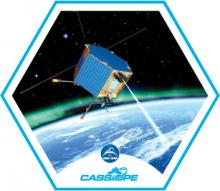CASSIOPE spacecraft monitors 2018 ARRL Field Day
CASSIOPE spacecraft monitors 2018 ARRL Field Day

The Canadian CAScade, Smallsat and Ionospheric Polar Explorer (CASSIOPE) spacecraft once again eavesdropped in on the 2018 ARRL Field Day. Onboard CASSIOPE is the Enhanced Polar Outflow Probe (e-POP), a suite of eight science instruments studying spaceweather. The Radio Receiver Instrument (RRI), one of e-POP’s eight instruments, was tuned to 7.005 MHz (40 m), during 6 passes over the North American continent during the Field Day activities. “We’re really happy with our results this year” remarked Dr. Gareth Perry, a Postdoctoral Research Associate in the Department of Physics and Astronomy at the University of Calgary, CASSIOPE’s home institution. “RRI recorded plenty of chatter between Field Day participants, especially during our passes over the eastern and central United States on the evening of the 23rd”.
CASSIOPE also participated in the 2015 and 2017 Field Day; its activities for the latter were heavily advertised. “The 2017 response from the Ham radio community was overwhelming! RRI’s band was inundated with CW signals. It’s been tough to sort out the 2017 data, so we decided to use a different tactic this year.” Dr. Perry and members of the Ham Radio Science Citizen Investigation (HamSCI) group coordinated with the Nashoba Valley Amateur Radio Club (NVARC, N1NC) and the Hoosier DX And Contest Club (N9NS) and the Indianapolis Radio Club to “direct traffic” – asking their members to stick to pre-selected frequencies during the passes, and to record their transmitting logs. “We figured that it would be easier to assign frequencies ahead of time so that we know where to look in post-processing, which seems to have paid-off” added Dr. Perry.
Dr. Perry and the HamSCI group have been using the ARRL Field Day as a opportunity to study space weather and HF radio wave propagation. “Not only have the Field Day experiments been valuable scientifically, but they have also helped promote the relevancy of Ham radio to the greater scientific community.” This year, CASSIOPE also had extra support from one of the more important space science facilities in the country, “Thanks to Dr. Phil Erickon’s (W1PJE) efforts, we were able to get some ionospheric diagnostics from the Millstone Hill Incoherent Scatter Radar, a large ionospheric radar with wide coverage over the US east coast. Millstone Hill ionospheric measurements during the CASSIOPE east coast passes will add another layer of critical information to our observations.” Dr. Perry hopes that CASSIOPE will participate in Field Day activities for as long as possible “we’re looking forward to next year already!”.
Dr. Perry is the lead-author on the first publication using data from the ARRL Field Day experiments, Citizen radio science: an analysis of Amateur Radio transmissions with e-POP RRI, which reports on CASSIOPE’s 2015’s ARRL Field Day activities. The article was recently accepted for publication in Radio Science. All e-POP data is available at the CASSIOPE/e-POP data portal at https://epop.phys.ucalgary.ca/data/. Please note: the RRI dataset is in HDF5 format. Preparations are underway to convert the RRI data to a more useable format for the Ham community. CASSIOPE/e-POP operations are funded by the European Space Agency (ESA) under the Third Party Mission Program. Radar observations and analysis at Millstone Hill are supported by a US National Science Foundation grant to the Massachusetts Institute of Technology.
